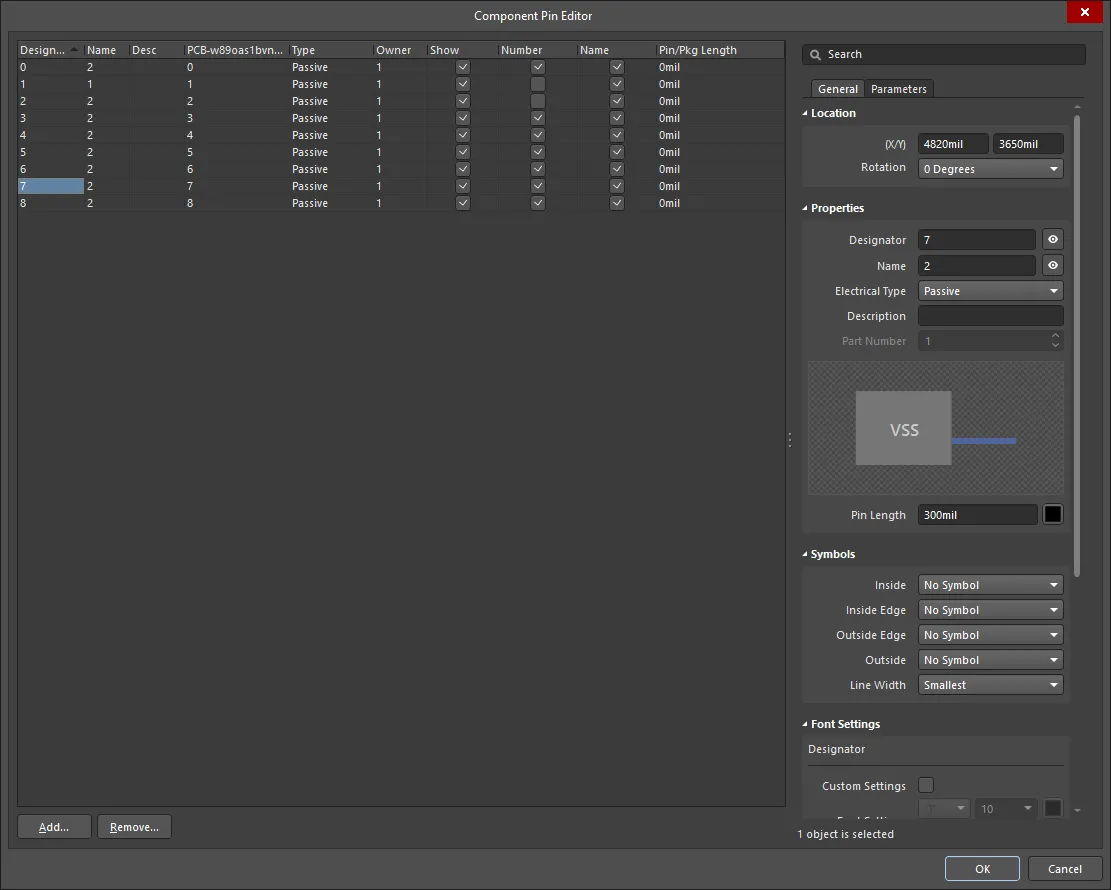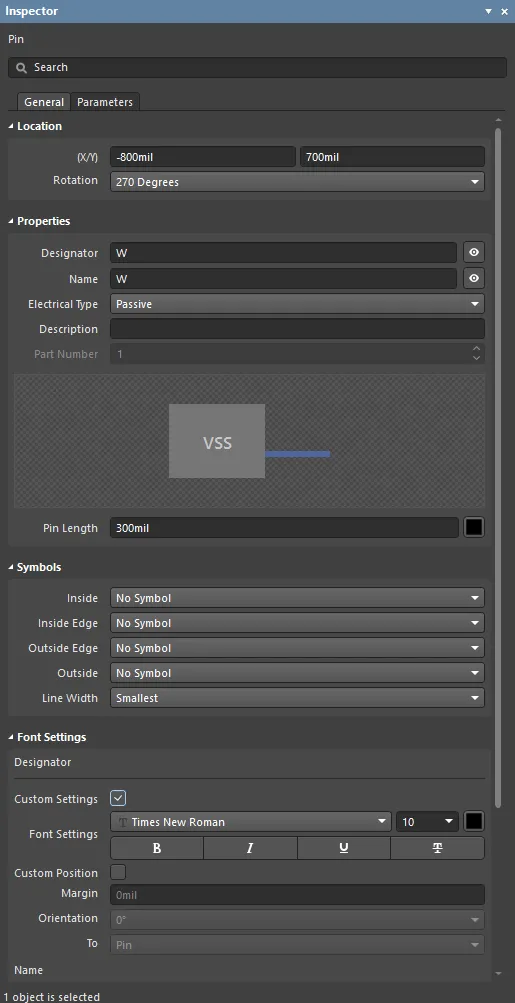Pins can only be placed in the schematic library editor. Use one of the following methods to place a pin:
- Click Home | Circuit & Graphical Elements | Pin from the main menus.

- Click the Add button in the Pin List region of the SCH Library panel.
- Click the Add button in the Pins tab of the Inspector panel in Component mode.
- Click the Add button in the Component Pin Editor dialog (described below).
New pins are added to the component that is currently visible in the schematic library editor. Select the required component in the SCH Library panel.
- Using one of the first two techniques described above, invoke the pin placement process. Note that the floating pin is held by the electrical end, which must be positioned away from the component body. Only one end of the pin is electrical and it is always this end by which the pin is held.
- Since there are often numerous pins on a component, it is more efficient to edit the properties of each pin as they are being placed. To do this, press Tab while the pin is floating on the cursor to open the Inspector panel. Click the pause button overlay (
 ) to resume placement.
) to resume placement.
- Edit the pin properties as required; typically this will include at least the Name, Designator, and Electrical Type.
- Press the Spacebar to rotate the pin if required. Rotation is counterclockwise in increments of 90 degrees.
- Position the pin, then click or press Enter to place the pin in the schematic library design space.
- Continue to place pins, or right-click or press Esc to terminate pin placement.
Create the component near the origin (center) of the Schematic Library Editor sheet, which is marked by dark cross-hair lines. Typically, a pin or the corner of the component body is placed at the sheet origin.
The pin number (Designator) must be defined since this is what is used to establish the connectivity. The Electrical Type is also important as this is used in the Schematic Editor for the Electrical Rules Check (ERC).
Adding Pins in the Component Pin Editor
Pins can also be added through the Component Pin Editor dialog, which is accessed by clicking on the pencil icon ( ) from the Inspector panel's Pins tab when in Component mode.
) from the Inspector panel's Pins tab when in Component mode.

Click the Add button to add a new pin then define the properties in the Component Pin Editor dialog. Note that multiple pins can be added and their properties defined; you can also use Tab and Shift+Tab to step between the fields. When you click OK to close the dialog, the new pin(s) are placed on the sheet to the bottom right of the component, ready to be positioned.
Notes on Pin Numbering
For many components, there will be a series of pins that have numerical names and numbers. The Auto-Increment During Placement feature on the Schematic - General page of System Preferences can be used to speed the placement of these pins. Auto-increment is invoked automatically if the pin properties are edited before placement (press Tab while the pin is floating on the cursor). The feature works for both the Designator and the Display Name - the pin Designator uses the Primary auto-increment field and the pin Display Name uses the Secondary auto-increment field. It supports incrementing alpha and numeric values and decrementing numeric values.
 Use the auto-increment feature to speed the placement of pins. Note the incrementing alpha pin name and decrementing numeric pin number.
Use the auto-increment feature to speed the placement of pins. Note the incrementing alpha pin name and decrementing numeric pin number.
Graphical Editing
To move a pin, click and hold. The cursor will jump to the electrical hotspot end of the pin. Move it to the new location, placing it with the electrical end away from the component body.
While dragging, the pin can be rotated (Spacebar) or mirrored (X or Y keys to mirror along the X-axis or Y-axis respectively).
Non-Graphical Editing
This method of editing uses the Inspector panel to modify the properties of a pin object.

During placement, the Pin mode of the Inspector panel can be accessed by pressing the Tab key. Once the pin is placed, all options appear.
After placement, the Pin mode of the Inspector panel can be accessed in one of the following ways:
- If the Inspector panel is already open, select the pin object, right-click then choose Properties from the context menu.
- With the pin selected, choose View | Schematic | Inspector from the main menus.
Pin Display Name and Designator - Position and Font
The location of the pin display Name and pin Designator (number) is defined globally by the Pin Margin settings on the Schematic - General page of the System Preferences. This is an environment setting, meaning it applies to the PC on which the setting is defined. The settings define a relative distance the text is away from the non-electrical end of the pin.
The default system font for a schematic library document is Times New Roman, 10pt, Regular. This is fixed and cannot be changed. When a library component is placed on a schematic sheet, this same default font is applied but is not fixed and can be changed as required. Keep in mind that the system font used for a schematic sheet applies to other objects as well, including Power Ports, Ports, and the X, Y region markers in the schematic sheet border.
For pins, these system-level settings of position and font can be overridden. Controls for customization of the position and font for a pin's Designator and Name can be found in the Pin mode of the Inspector panel. Use the Custom Position option to change the default settings for the position to an overriding, customized position. For the Margin, enter a new value directly in the associated field. For the Orientation, use the drop-down to choose the angle (0° or 90°) and the To reference (Pin or Component).
Use the Custom Settings option to change from following the default system font to an overriding, customized font.
Pin Symbol Line Width
When representing a component in the schematic editing domain, each pin defined as part of that device's schematic symbol can have one or more symbols displayed. These are symbols displayed on the Inside, Inside Edge, Outside, or Outside Edge in relation to the main component symbol outline, as required. Examples include a Clock symbol on the Inside Edge or a Dot symbol on the Outside Edge. Such symbols greatly improve the readability of the design through the visual indication of the purpose of the signal traversing a particular pin.
Use the Line Width property available in the Symbols region of the Inspector panel to determine the width of the line used to draw these symbols.